7+ Ecommerce Inventory Management Software Solutions to Create a Seamless Customer Experience
How accurate are your inventory numbers?
Do you know how much you have available to ship from your warehouse?
What about in-store? (If you have a brick-and-mortar location)
Does your system show you only inventory of what’s being sold from your ecommerce site and you have to manually sync purchases from a marketplace (like Amazon)?
Manual inventory is not only incredibly outdated, but a huge waste of time and resources.
If you’re still doing it, make a note to email your team after you read this post that you’ve made a decision to stop the madness!
Poor inventory management can stifle your sales growth, spoil customer experience, and ruin your brand’s image with customer complaints of lost orders, delayed shipments, and more.
But, you can get your inventory under control with a good inventory management software.
By syncing with your current ecommerce platform, inventory management software updates stock levels automatically across all platforms (including ecommerce marketplaces like eBay or Amazon) in real time, so you aren’t losing your mind (and time) over manually updating spreadsheets!
This article will review some of the top management solutions that will allow you to manage your inventory in a more streamlined and efficient way.
The Different Types of Inventory Management Software
First, you need to understand the difference between basic inventory management softwares and multichannel inventory management softwares:
A basic inventory management software does things like track inventory history, shipping information, and restocking. It fulfills the most basic management needs. But as businesses begin to grow, a basic solution may not be able to keep up. That’s when a company needs to start looking at implementing a multichannel solution.
A multichannel inventory management software is more complex than a basic inventory management software, and can integrate all your sales channels under one hub to seamlessly track inventory. It is more useful to companies who have many retail stores, need to sync their inventory with online sales, and sync with any other sales channels they have (pop-up shop, retail partners, etc.).
So, where do you fit in?
Basic Inventory Management Software
You should use this if: you have a low volume of orders per month (less than 1,000) and your only sales channels are a single (or a few) physical stores plus your ecommerce website.
Generally, a basic inventory management software solution allows you to:
- organize your products by categories and locations
- use movement history to control and optimise stock levels by preventing overstock and outages
- track sales, orders, deliveries, and order fulfilments
One example of a basic Inventory Management Software is Inflow Inventory, which allows you to maintain a full trail of paperwork like invoices, pick up slips, packing slips, box labels, purchase orders, and more.
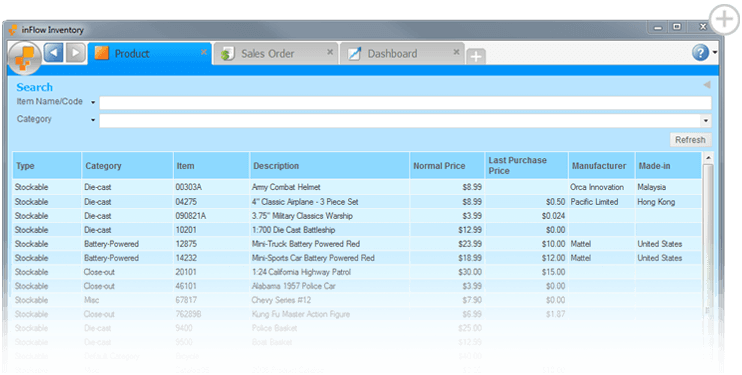
Inflow helps you scale operations through the use of barcode scanners and other technology designed to help manage your inventory more quickly. You can even use multiple units of measurement, track multiple locations and sub locations, full movement history, and track items with unique serial numbers. (source)
Fishbowl Inventory is another inventory-centric management software, great for companies that manufacture their own products. It provides features such as asset management, raw materials management, cycle counting, and customized reporting. In addition, the Fishbowl team has compiled a great library of training resources to support you as you learn and scale with the software application. (source)
Some ecommerce platforms come with inventory tracking built in. These may not be as detailed as pure inventory management softwares like Inflow and Fishbowl, but they can help you manage your inventory without investing in a full blown solution.
So, if you’re looking to do a new build or replatform your existing ecommerce website, you may consider what your platform has to offer already.
Shopify can help you track inventory and display inventory numbers in the platform’s admin panel. If you’re looking to get deeper into Inventory management, you’ll need to look at the Shopify App Store and integrate an inventory management app to your store.
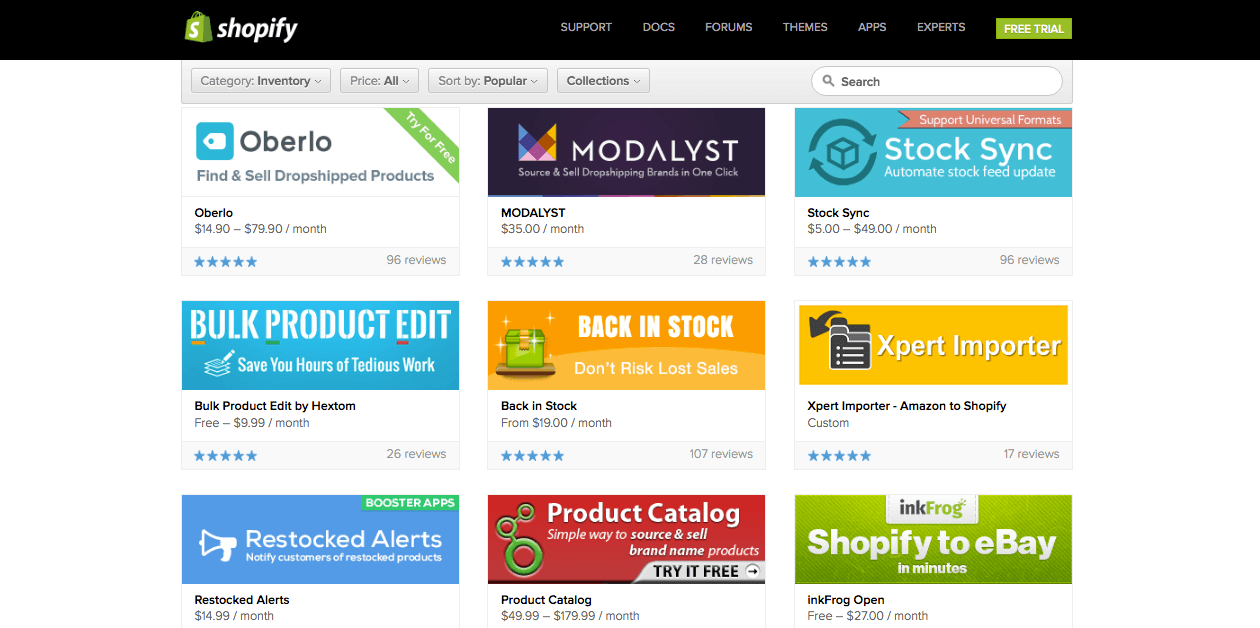
Magento, on the other hand, has a dedicated inventory management software of their own.
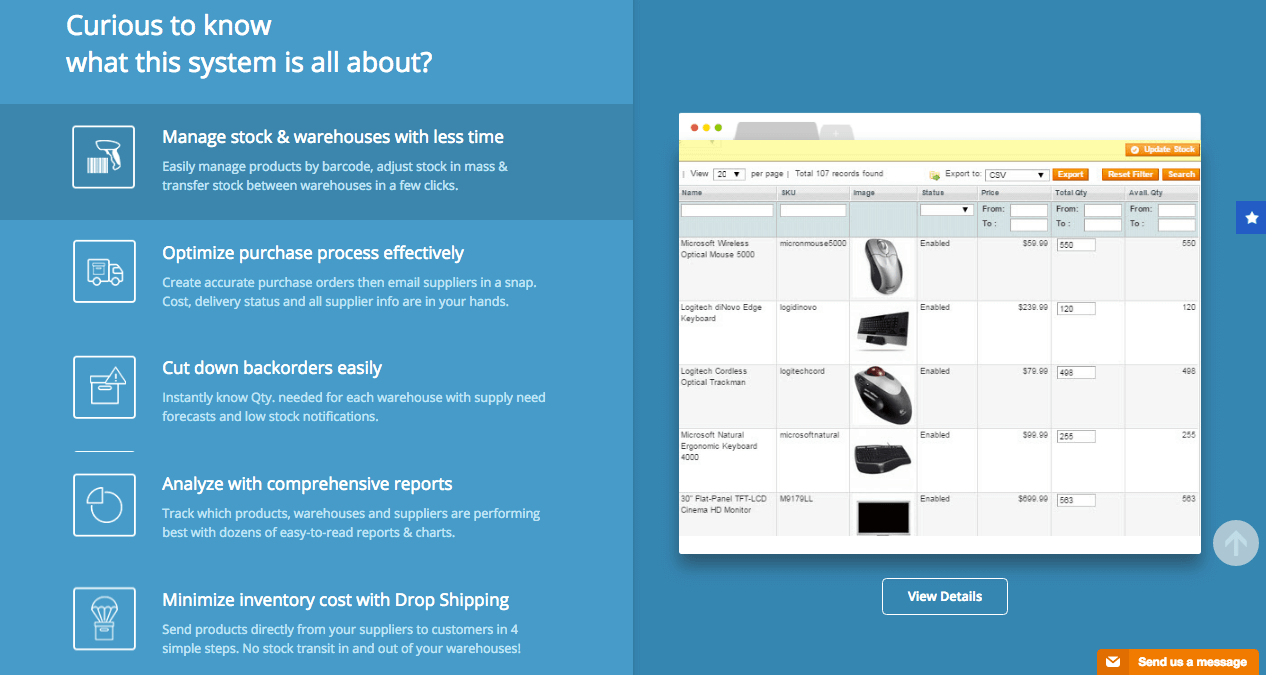
It’s an extremely comprehensive software covering all aspects of inventory management, including managing stock, purchase orders, forecasting supply needs, notifications on low stock, managing multiple warehouses, managing multiple shipments and much more.
But, the best thing about this is that you don’t have to worry about any loss of data to a third party application, as you’ll have all your data stored on the Magento platform.
Critical Questions to Ask Yourself to Find the Best Basic Inventory Management Software
Before you begin looking into a software solution or changing to a new one, you need to sit down with your team and answer the below questions:
- Have you ever oversold a product on your website?
- Have you accounted for your inventory management costs?
- How much time are you spending on manual processes related to your inventory?
- Have you ever received negative customer feedback on product outages?
- How are you currently managing your inventory?
- Are you aware of which inventory management tools you have on your ecommerce platform?
After answering these questions, next ask yourself “why” for each.
For example, why have you oversold a product on your website?
Possible answer: Because my inventory sold in-store isn’t updating real-time, so we’ve oversold through our website.
After you’ve asked “why” for each bullet point, you’re now armed with the underlying explanation for your poor system. This is the best information you can have when looking for and deciding on a software solution.
Multichannel Inventory Management Software
You should use this if: you have a high volume of orders per month (more than 1,000), and you have multiple sales channels that need inventory synchronization – like multiple brick-and-mortar locations, your ecommerce website, pop-up shop(s), third-party retail, etc.
If your company fits that description, you need something much more robust than just a basic inventory management software… and a multichannel solution will fit the bill.
Multichannel inventory management software updates inventory levels in real-time, ensuring you don’t oversell a product through any one channel at the expense of another channel’s revenue.
A Few Best In Class Multichannel Solutions
If multichannel sounds like it’s for you, consider one of these top-notch solutions we love.
Netsuite
You should use this if: you have multiple channels you’re wanting to synchronize, and want to utilize the real-time data from the channels to personalize your customers’ experience online and/or in-store.
Netsuite is a leading provider of multichannel management software. Dylan’s Candy Bar, a well known candy retailer, has used Netsuite to achieve double digit revenue growth. With a comprehensive inventory, financial, and order management software solution, Dylan’s has been able to streamline business operations and support rapid growth.
Netsuite’s omnichannel solution has also helped Dylan’s provide personalized cross-channel marketing by having a central repository of cloud based customer information from all sales channels.
This has helped their in-store staff provide a personalized customer experience to people who visit their physical stores. By accessing information on their birthdays, loyalty points, and past purchases via this repository, they’re able to make customers feel special.
Dylan’s has also reduced ecommerce order processing times by 66% by using centralized order processing, resulting in an increase 32% increase in orders.
Having access to inventory information in real time has allowed the business to be more agile and responsive to customers through reduced inventory discrepancies and expanded retail partnerships, adding even more fuel to their rapid growth. (source)
Netsuite Pros
- allows you to utilize data to streamline your customer experience
- encompasses the ERP, CRM, and accounting functionality you would expect to get from leading software packages – in one integrated system
- takes away the headaches associated with having to integrate multiple software solutions from different vendors. (source)
Netsuite Cons
- Netsuite is tries to be “everything for everyone” and therefore falls flat in some areas (but this can be applicable for some businesses and not others). For example, Netsuite may fall short for someone in distribution or manufacturing, but if you’re using it as an ecommerce company, the pros seem to outweigh the cons.
Elastic
You should use this if: you are a B2B retailer and want to streamline your operations between your company and third-party retailers (partners or dealers).
Elastic, another company that’s dedicated to providing B2B digital solutions to manufacturers, has helped The North Face drastically improve their sales.
Through Elastic’s visual inventory merchandising, their sales reps are able to build custom catalogs before they speak to retail partners for new orders, something that’s unique compared to other softwares.
Visual inventory merchandising allows reps to make visually appealing presentations to dealers and retail partners, which saves a lot of time when it comes to ordering and selecting products.
Clearly, it’s quite an innovative solution to inventory management, supporting account executives in sales and account management.
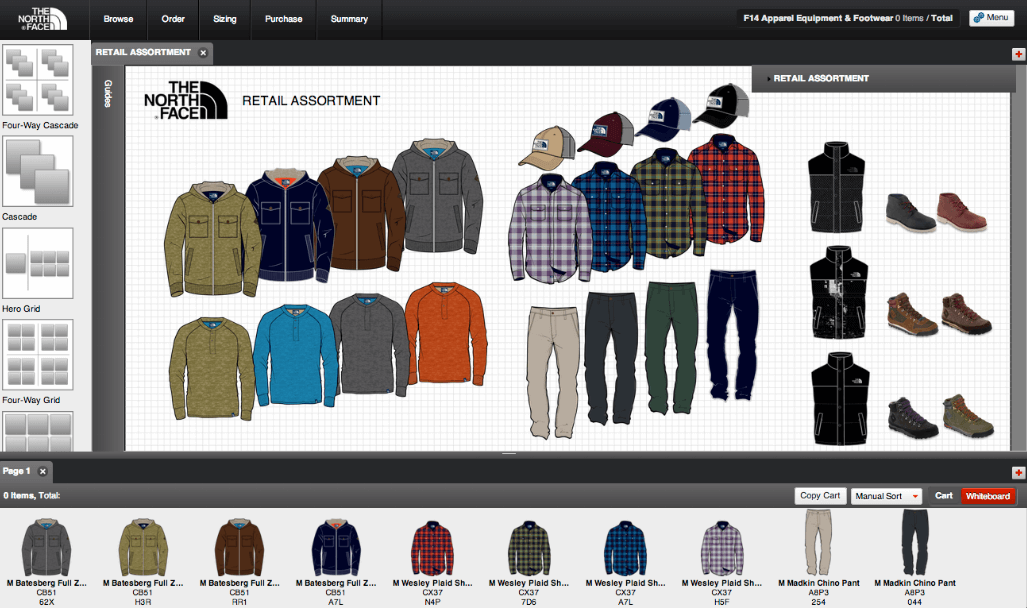
Elastic Pros
- you can build a digital/custom catalog to share with your third-party retailers to eliminate traditional printed workbooks
- whiteboarding tools allow you to do things like plan for preseason
- leverage your Marketing Assets to make the interface feel like your B2C site
Elastic Cons
- it seems the customer service and ease of use may not be 5-star, but overall the pros of this solution greatly outweigh the cons
- see more reviews here
Retail Ops
You should use this if: your business has multiple channels, complex operations like a combination of drop-shipping, just in time fulfillment, and internally fulfilled products, or if you need to further customize your multichannel inventory management solution.
Retail Ops, an operations management software used by well known retailers like Dot & Bo and Huckberry, makes ecommerce businesses scalable through efficient inventory management. It’s built by retailers, for retailers, so it’s clear they understand the problems of omnichannel retail businesses.
Retail Ops is a process-oriented software. Combining cloud based data storage, multi-platform integration, intuitive management process, and real time reporting and analytics, they operate on a SaaS model which prevents you from getting ‘locked in’.
Through their flexible API they give you full control over your data, as well as the modules within the software. They’re a highly versatile software solution for omni channel retailers.
A company they’ve made a huge difference to is ShoeMetro, an online shoe retailer and one of the fastest growing private retailers in America. Within their first year of using Retail Ops, ShoeMetro reduced operational headcount by over 30%, increased product output by 24%, and unlocked $960,000 in ROI. With streamlined vendor purchase order management and efficient warehouse management, the software allowed the business to scale fast. (source)
Retail Ops Pros
- flexible built in modules allow each business to only use what modules they require
- very flexible API, making it easy build more complex or project specific integrations with tools you already use
Retail Ops Cons
- Retail Ops may take a revenue share of your sales (based on a 2014 Reddit thread from a potential Retail Ops customer you can read here)
Brightpearl
You should use this if: you’re trying to consolidate the amount of softwares you’re using to track inventory across all channels into one solution.
Brightpearl is another great multichannel inventory management software that integrates across marketplaces and ecommerce platforms. It’s helped boost The Triathlon Shop’s online sales by 600% and also save close to £16,000 a year (Approximately $23,358 USD) in inventory management costs.
Before using Brightpearl, they were using an ad hoc mix of tools like Microsoft Dynamics and Excel (!!!) to manage operations. But once they began to sell on their website as well on eBay, they faced a lot of operational challenges like having to update inventory levels manually, a disconnect between sales channels, and lack of data and insights on the business.
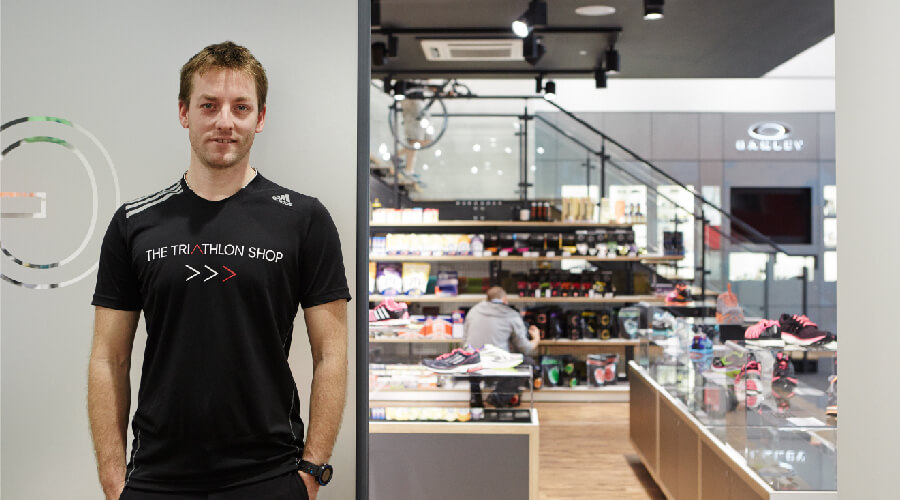
With Brightpearl, they centralized order management, accounting, and customer follow ups for all sales channels, all from one screen. That’s the power of being able to multitask between key operational drivers in a multi channel retail business with Brightpearl!
Brightpearl Pros
- strong inventory management
- fast and current connection to online orders, stock, and inventory
- integrates well with all leading shipping carriers
- bug fixes and updates are issued regularly
Brightpearl Cons
- based on customer reviews, it seems the main “con” of Brightpearl is the setup
- it’s pricey and quite complex, so the system may take some time to get used to
- additionally, as it is a U.S.-based company, there may be oddities if operating from a different country (this will surely be fixed as Brightpearl itself grows)
Stitch Labs
You should use this if: you want to track inventory across multiple channels like marketplaces (Amazon, eBay, etc.), or are experiencing extreme headaches with managing inventory and orders manually.
Stitch Labs is a great product that syncs across sales channels, point of sale systems, ecommerce sites, marketplaces, and warehouses to be a comprehensive solution allowing you to scale your business.
Chubbies, a San Francisco based apparels company, initially struggled with manual data entry relating to order fulfillment. Their staff would spend more than half a day, every day, on communicating orders to logistics providers, as well as adding products to order as part of the customer loyalty program.
With Stitch’s enterprise API, Chubbies has been able to integrate their loyalty program into their inventory management software, cutting the time in adding loyalty gift products to fulfilments orders. They can easily change loyalty gifts, too, allowing them to see which gifts drive more repeat purchases.
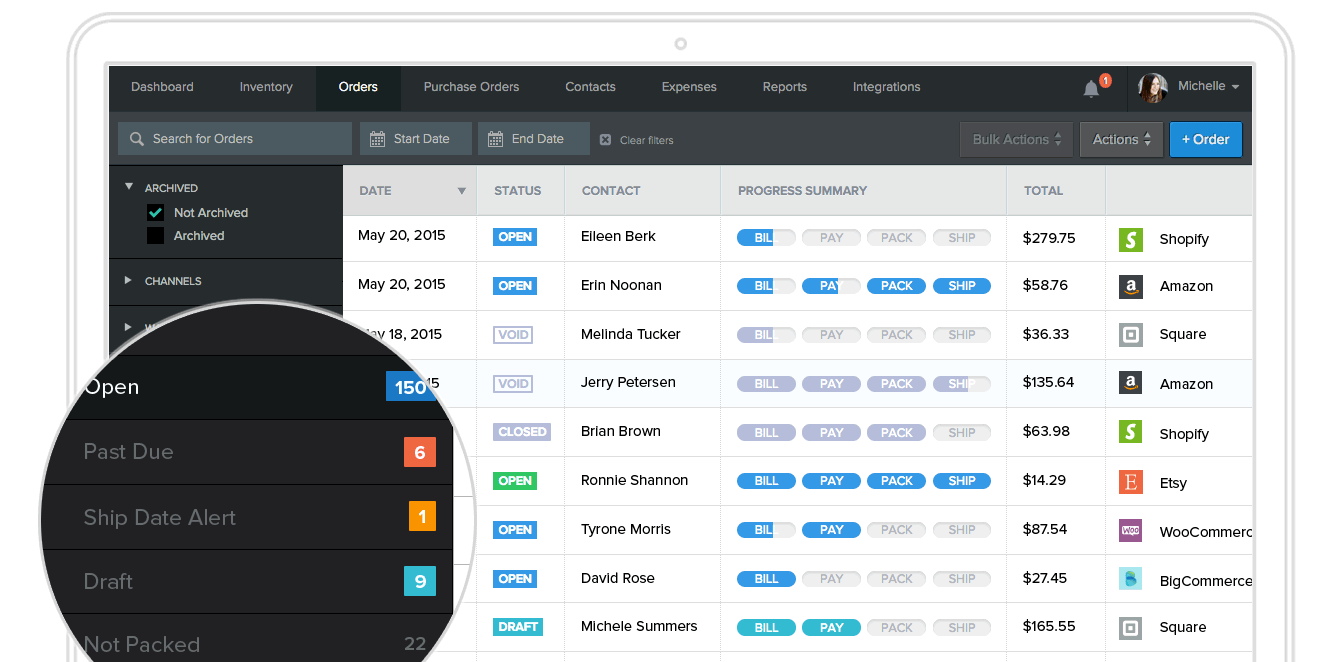
Another problem Stitch has solved for Chubbies is what to do when a customer enters the wrong address while placing an order. Before, they would have to inform the logistics provider within a 6 hour window about the incorrect address to prevent the shipment from being sent out.
With Stitch, this process has become a lot more efficient. Chubbies can now just update the correct address on the system for an automatic notification to be sent out to the logistics provider, reducing faulty shipment costs.
With all the advantages of Stitch, Chubbies has been able to save 3.75 hours a day that they would usually spend towards manual order fulfillment. (source)
Stitch Labs Pros
- integrates well with marketplace channels (like Amazon and eBay)
- integrates well with softwares like QuickBooks and Square
- features the ability to create custom reports so you can accurately analyze your channels individually or in comparison to one another
Stitch Labs Cons
- based on customer reviews you can find on software review sites like GetApp, it seems there are cons in terms of how a contact or customer is tracked in the system, so Stich Labs is probably lacking a bit on the CRM-side of things
- lacking support for barcode scanning as a means of inventory tracking
- customer support is totally chat-based, unless you upgrade your plan to include phone support
Sellbrite
You should use this if: you want to track inventory across multiple channels like marketplaces (Amazon, eBay, etc.) and looking to cut down your order processing time.
Lastly, let’s look at Sellbrite. With it’s simple, intuitive interface and great customer service, Sellbrite is another choice for continuous inventory syncing.
You can automate rules for each channel individually to reflect inventory scarcity, show heavy stock or keep a reserve, depending on your strategy.
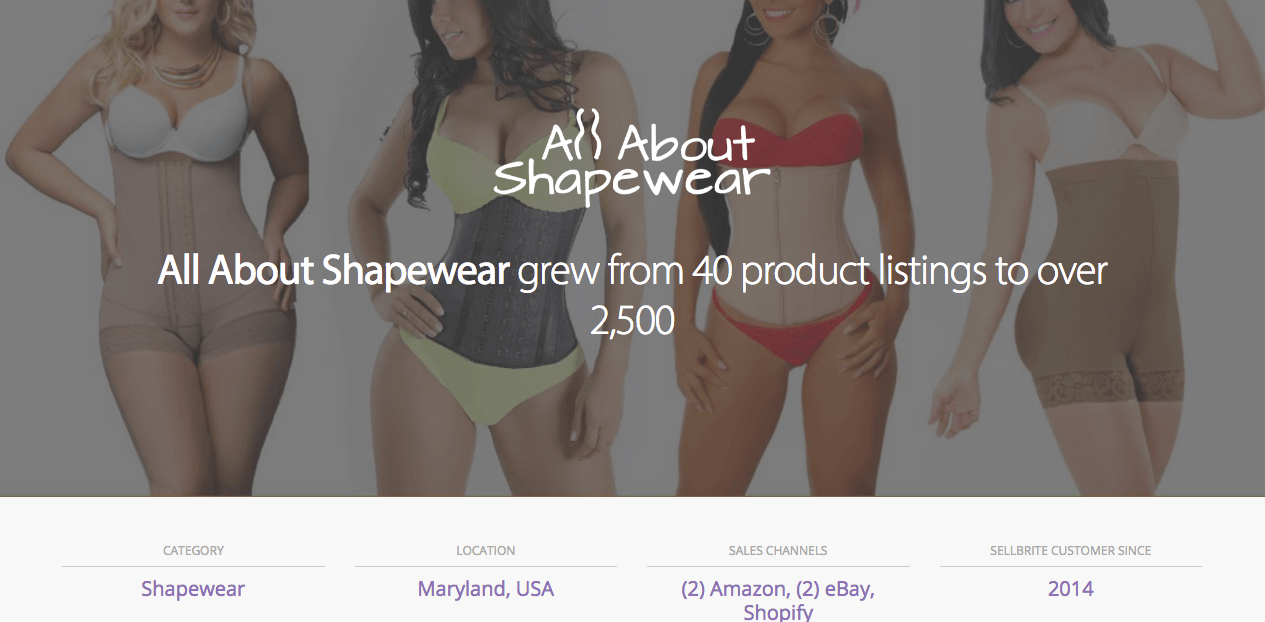
Online retailer All About Shapewear recently implemented Sellbrite to help sync inventory between their eBay and Shopify stores. In December of 2014, All About Shapewear featured 20 SKUs on 2 channels, or 40 total product listings. By December of 2015, they offered over 2500 listings across 5 sales channels!
Since then, sales for the brand have grown an average of 10% per month for the last 13 months, and finished at over $500k for 2015. You can read the full case study here.
Sellbrite Pros
- easy setup to get all of your channels under one umbrella quickly (short learning curve)
- integrates well with most popular ecommerce platforms
- allows you to automate many processes (ex.: create bulk listings)
Sellbrite Cons
- You can see what others think are “cons” of the software, but it seems that they are constantly rolling out improvements and new features.
What Can You Do NOW?
The key takeaway for you is to choose an inventory management software that best fits your ecommerce business. Evaluate the results you’d get by choosing each one to make the best decision.
Ideally, the benefits should be a combination of:
- increased operational efficiency,
- employee productivity,
- improved data accuracy,
- optimum inventory levels
- and real time inventory tracking.
What has been your biggest challenge with inventory management? Let us know in the comments below.
[rad_rapidology_inline optin_id=optin_24]
*This post was co-authored by our Director of Marketing, Jenna.







